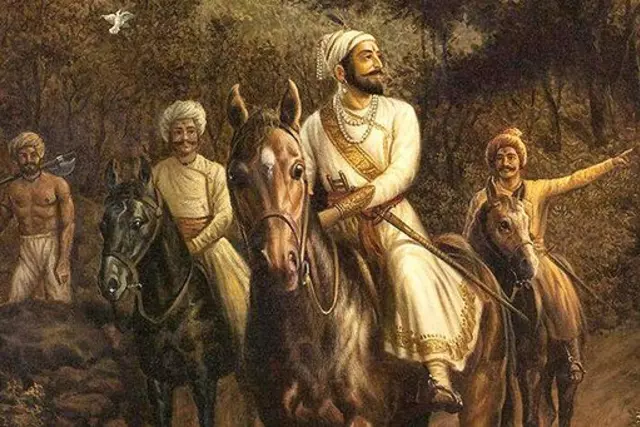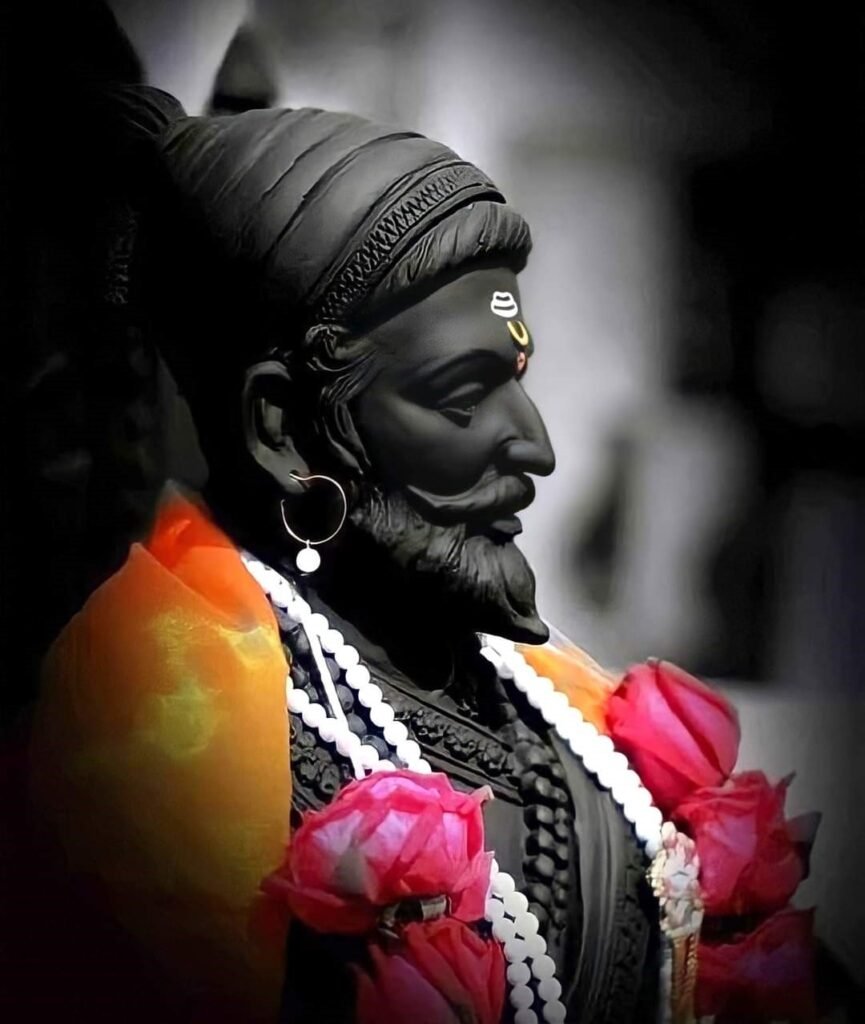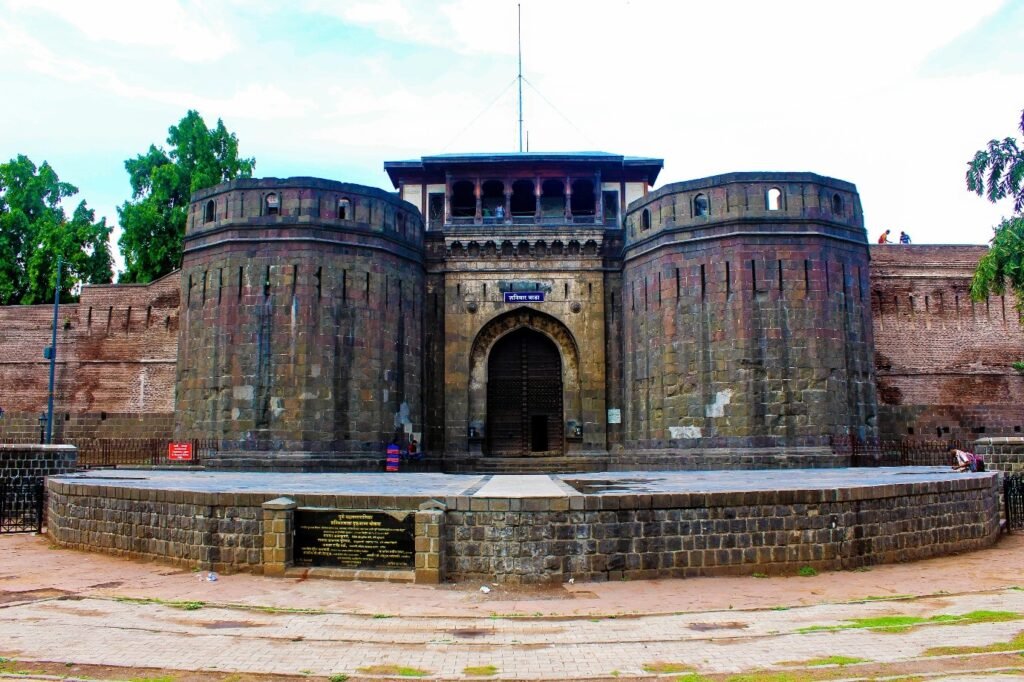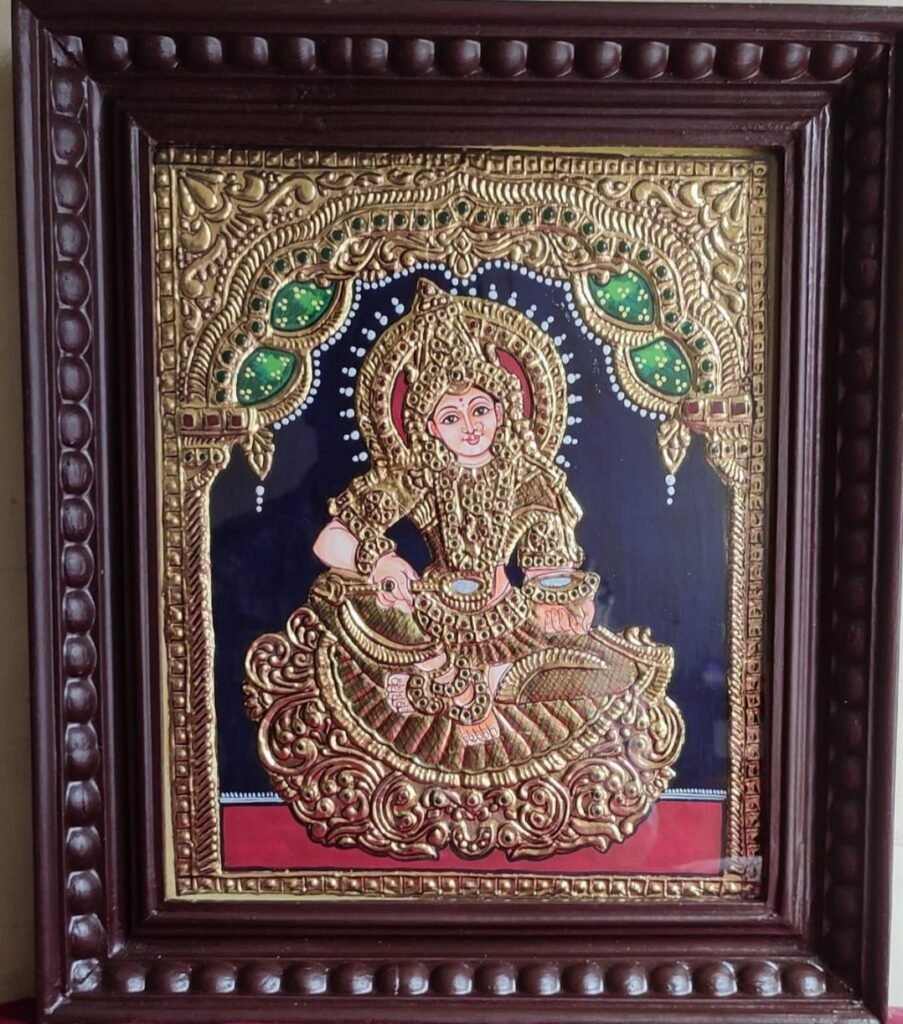The Maratha Empire stands as a pivotal chapter in India’s medieval history, leaving an indelible mark on the subcontinent’s political landscape. Rising amidst the decline of the Mughal Empire in the 17th century, the Marathas, under the visionary leadership of Chhatrapati Shivaji Maharaj, carved out a powerful kingdom rooted in military prowess and innovative administrative structures. In this article, you will learn about Shivaji, his successors, Peshwas, First-, Second- and Third Anglo-Maratha War, etc.
This article will provide key insights for GS Paper- I Indian History of UPSC IAS Exam.
Table of Content
- Rise of the Marathas
- Shivaji (1627-1680)
- Successors of Shivaji
- The Peshwas (1713-1818)
- First Anglo-Maratha War (1775-82)
- Second Anglo-Maratha War (1780-84)
- Third Anglo-Maratha War (1817-18)
- What led to the decline of Maratha Empire?
- Administration under Maratha Empire
- Architecture during Maratha Empire
- Painting during Maratha Empire
- Religion & Society during Maratha Empire
- Conclusion
- Frequently Asked Questions
Rise of the Marathas:
- The Marathas rise during the 16th and 17th centuries were caused by factors such as the rugged terrain and dense forests which led to their proficiency in guerrilla warfare.
- To fortify their strategic position, they erected numerous forts atop the mountains.
- The spread of the Bhakti movement within Maharashtra had sowed the seeds of religious cohesion amongst them.
- Spiritual leaders like Tukkaram, Ramdas, Vaman Pandit, and Eknath had played a pivotal role in cultivating social harmony.
- The Marathas have earlier occupied significant roles within the administrative and military frameworks of the Deccan Sultanates of Bijapur and Ahmadnagar.
- Several influential Maratha clans, including the Mores and Nimbalkers held prominence in the Sultanate.
- However, the distinction of establishing a formidable Maratha dominion begins by Shahji Bhonsle and his son Shivaji.
Shivaji (1627-1680):
- Born in 1627 at Shivner, Shivaji’s parents included Shahji Bhonsle as his father and Jija Bai as his mother.
- He had inherited the Poona jagir in 1637, which belonged to his father.
- In 1647, his guardian Dadaji Kondadev passed away, and so Shivaji took full control of his jagir.
- Prior to this, he had already triumphed over Raigarh, Kondana, and Torna, by fighting against the Bijapur ruler.
- He had annexed Javli from Chanda Rao More, a prominent Maratha leader, thus extending his dominance over the Mavala region.
Conquest with the Bijapur kingdom:
- In 1657, Shivaji plundered the Bijapur kingdom and secured numerous hill forts in the Konkan region.
- The Bijapur Sultan had dispatched Afzal Khan to counter Shivaji’s advances, but Afzal Khan met his demise at the hands of Shivaji in 1659.
- Shivaji’s military exploits had transformed him into a revered figure across the Maratha domain, inspiring many to join his ranks.
Conquest with the Mughals:
- Emergence of Maratha power under Shivaji had caught the watchful eye of the Mughal emperor Aurangazeb.
- In response, Aurangazeb had dispatched Shaista Khan, the Mughal governor of the Deccan, to quell Shivaji’s ascendancy.
- Defeat and loss of Poona had initially marred Shivaji’s efforts, but he retaliated by attacking Shaista Khan, which tarnished Khan’s reputation, prompting his recall by Aurangazeb.
- In 1664, Shivaji raided Surat, the principal Mughal port.
- Subsequently, Aurangazeb had dispatched Raja Jai Singh of Amber to subdue Shivaji.
- The siege of Purandar fort, where Shivaji’s family and riches were present were ensued.
Truce between Marathas and Mughals:
- Eventually, negotiations between Shivaji and Jai Singh culminated as the Treaty of Purandar in 1665.
- According to the treaty, Shivaji had relinquished 23 forts to the Mughals while retaining the remaining 12 on the stipulation of loyalty to the Mughal empire.
- Concurrently, the Mughals acknowledged Shivaji’s territorial claims within the Bijapur kingdom.
Legacy of Shivaji:
- As Shivaji have requested exemption from personal service to the Mughals, his younger son Shambaji was conferred a mansab of 5000.
- In 1666, Shivaji had journeyed to Agra, where he was captured.
Shivaji’s captivity & Aftermaths:
- He was successful to escape, he thus became hostile against the Mughals again.
- He plundered Surat once more in 1670 and reclaimed territories through his conquests.
- In 1674, he was crowned at Raigarh and he adopted the title, Chatrapathi.
- An expedition into the Carnatic region made Shivaji seize Ginjee and Vellore.
- However, his demise occurred upon returning from this expedition in 1680.
Successors of Shivaji:
- The demise of Shivaji led to a succession struggle amongst his progeny, Shambaji and Rajaram, to control the kingdom.
- In the power tussle, Shambaji emerged as the victor, but later he fell into the clutches of the Mughals, leading to his execution by their hands.
- Subsequently, Rajaram ascended the throne, but his reign was characterized by constant upheaval.
- Pressured by Mughal forces, he was compelled to seek refuge within the fortified walls of Ginjee.
- After this, the reins of power were given to his young son, Shivaji II, who had assumed the title under the regency of his mother, Tara Bai.
- Shahu ultimately led to the rise of the Peshwas, who then become a central force of the authority.
The Peshwas (1713-1818):
Balaji Viswanath (1713-1720):
- Balaji Viswanath had commenced his journey as a revenue functionary, and became Peshwa in 1713.
- His elevation was a turning point, as he not only secured a commanding and preeminent role for himself but also enshrined its hereditary nature.
- He had skillfully orchestrated events that culminated as the ascent of Shahu as the Maratha sovereign.
- His tactfully consolidated support from various Maratha leaders to rally behind Shahu’s cause.
- In 1719, Balaji Viswanath secured significant concessions from the reigning Mughal emperor of the time, Farukh Siyar.
- This led the Mughal emperor to extend recognition to Shahu, bestowing upon him the titsle of Maratha king.
- Shahu was granted the authority to levy Chauth and Sardeshmukhi from the six Mughal-administered provinces ranging from the Deccan, to the territories of Carnatic and Mysore.
- This marked a testament to Balaji Viswanath’s political acumen and strategic prowess in shaping the course of Maratha history.
Baji Rao I (1720-1740):
- Baji Rao, the eldest progeny of Balaji Viswanath hadassumed the title of the Peshwa at the age of 20, by succeeding his father’s position.
- Under his leadership, the zenith of Maratha influence was attained.
- He formulated a confederateframework by interlinking the Maratha chieftains.
- This facilitated the allocation of distinct territories to individual Maratha chiefs, thereby granting them the prerogative of autonomous administration.
- This transformation bore fruit as various Maratha lineages had solidified their dominion across India such as Gaekwad dynasty presided over Baroda, the Bhonsles over Nagpur, the Holkars over Indore, the Scindias over Gwalior, and the Peshwas maintained their supremacy over Poona.
Balaji Baji Rao (1740-1761):
- Stepping into the role of Peshwa at age of 19, Balaji Baji Rao had inherited his father’s position.
- The demise of the Maratha monarch Shahu in 1749, bereft of an heir had culminated in the ascension of his appointedsuccessor, Ramraja.
- This heir was however imprisoned under the authority of Peshwa Balaji Baji Rao in Satara.
- Consequently, the reins of the Maratha dominion converged under the formidable leadership of the Peshwa.
- In 1752, an accord was forged between the Peshwa and the Mughal Emperor, stipulated the Peshwa’s commitment to safeguard the Mughal Empire from both internal and external adversaries.
- In exchange the Marathas can collect Chauth from the northwest provinces and revenue from the Agra and Ajmer provinces.
- When Ahmad Shah Abdali’s incursion into India became large, the mantle of safeguarding the nation was shouldered by the Marathas.
- The gallant Maratha troops had engaged in a fierce struggle against Ahmad Shah Abdali during the Third Battle of Panipat in 1761.
- Despite their valiant efforts, the Marathas were vanquished, leaving behind legacy of fallen leaders and countless soldiers.
- Balaji Baji Rao himself succumbed to the news of this mournful culmination.
First Anglo-Maratha War (1775-82):
- Since the Third Battle of Panipat in 1761, the Marathas became disunited.
- This internal discord among the Maratha factions was exploited by the expansionist British policy.
- A discord over the Peshwa’s position between Madhav Rao and his uncle Ragunatha Rao arose in 1775.
- The British authorities in Bombay had capitalized on this turmoil which culminated in the Treaty of Surat with Raghunatha Rao in 1775.
- Treaty of Surat led Britain to gain control over Bassein and Salsette, yet when RaghunathRao reneged on the promise, the British laid claim to these territories.
- However, this was disapproved by Warren Hastings’.
- In 1776, Warren Hastings had dispatched Colonel Upton to mediate the conflict and the Treaty of Surat was annulled and replaced by the Treaty of Purandar with Nana Fadnavis, prominent Maratha leader.
- Under the Treaty of Purandar, Madhava Rao II had assumed the role of the new Peshwa, and the Britishers can retain control over Salsette, accompanied by a substantial war indemnity.
- The Treaty of Purandar was rejected by Warren Hastings and the British military actions were initiated against the Marathas.
- The Marathas emerged victorious against the British forces dispatched by the Bombay Government and the Treaty of Wadgaon was signed under which British had to relinquish all the acquired territories since 1775.
- In 1781, Warren Hastings had deployed British troops under Captain Popham’s command.
- This deployment culminated in a series of small-scale engagements in which the Maratha chieftain, Mahadaji Scindia had suffered defeat.
- Gwalior was captured by the British forces.
- Subsequently, the Treaty of Salbai was signed between Warren Hastings and Mahadaji Scindia in May 1782.
- Treaty of Salbai facilitated the transfer of Salsette and Bassein to the British, while Raghunath Rao was pensioned off and Madhav Rao II as the Peshwa was recognized.
- The Treaty of Salbai had solidified British influence in Indian politics and brought two decades of peaceful coexistence between the British and the Marathas.
- The Treaty of Salbai empowered the British to exert their influence over Mysore, seeking assistance from the Marathas to reclaim their territories from Haider Ali.
Second Anglo-Maratha War (1780-84):
- Following Peshwa Madhavrao Narayan’s demise in 1795, Bajirao II, the less capable son of Raghunathrao, adopted the title of Peshwa.
- Nana Phadnavis, a staunch adversary of Bajirao II, assumed the role of chief minister.
- The internal discord among the Marathas presented the English with an opportunity to meddle in Maratha affairs.
- The passing away of Nana Phadnavis in 1800 further strengthened the British position.
- In 1801, the Peshwa executed Jaswantrao’s (or Yashwantrao) brother, Vithuji Holkar.
- Infuriated, Jaswant mobilized his forces against the combined armies of Sindhia and Bajirao II.
- Jaswantrao won over the Peshwa’s and Sindhia’s forces, who then installed Vinayakrao, Amritrao’s son, on the Peshwa’s throne.
- Fleeing to Bassein, a terrified Bajirao II signed a treaty with the English in 1802.
- The Treaty of Bassein (1802) saw the Peshwa agreeing to several terms, including-
- Receiving a standing force of native infantry stationed permanently in his territories
- Ceding territories generating an income of Rs 26 lakh to the Company
- Surrendering the city of Surat
- Relinquishing claims for Chauth on the Nizam’s dominions
- Accepting the Company’s arbitration in disputes with the Nizam or the Gaekwad
- Subjecting relations with other states to English oversight
- Following the Peshwa’s acceptance of the subsidiary alliance, Sindhia and Bhonsle attempted to preserve Maratha independence.
- However, the Arthur Wellesley prevailed, compelling separate subsidiary treaties with Sindhia and Bhonsle.
- In 1804, Jashwantrao Holkar sought to forge a coalition of Indian rulers against the English, but this endeavour proved fruitless.
- The Marathas were defeated, coerced into British vassalage, and were separated from one another.
Significance of the treaty:
- With troops stationed in Mysore, Hyderabad, and Lucknow, the addition of Poona under the British rule ensured a more evenly distributed force, deployable without undue delay when needed.
- It allowed company a favourable position to extend its sphere of influence.
Third Anglo-Maratha War (1817-18):
Background:
- Lord Hastings held grand aspirations to enforce British paramountcy.
- The Charter Act of 1813 ended the East India Company’s trade monopoly in China, excluding tea, prompting a quest for new markets.
- The Pindaris, a diverse group, served the Maratha armies as hired soldiers.
- With the weakening of the Marathas, the Pindaris were left without regular employment, leading them to plundering neighbouring territories, including those of the Company.
- The English accused the Marathas of harboring the Pindaris.
- Notable Pindari leaders like Amir Khan and Karim Khan surrendered, while Chitu Khan sought refuge in the forests.
- The Treaty of Bassein, offended other Maratha leaders, who viewed the treaty as an absolute surrender of their independence.
- Lord Hastings’ actions against the Pindaris were perceived as an encroachment on Maratha sovereignty, rekindling unity within the Maratha confederacy.
Course of war:
- Bajirao II rallied the Maratha chiefs against the English during the Third Anglo-Maratha War in 1817.
- The Peshwa moved towards Poona, while Appa Sahib of Nagpur targeted the residency in Nagpur, and the Holkar prepared for war.
- The political and administrative conditions in all Maratha states were disordered and ineffective, leading to weakening position of Marathas.
- After the demise of Jaswantrao Holkar, Tulsi Bai assumed a leading role in Poona.
- Due to influence from undesirable figures like Balram Seth and Amir Khan.
- Both the Bhonsle in Nagpur and the Sindhia in Gwalior had weakened significantly.
- In response, the English counterattacked vigorously, thwarting the Peshwa’s attempts to reassert authority over the Maratha confederacy.
Outcome
- The Peshwa was defeated at Khirki, the Bhonsle at Sitabuldi, and the Holkar at Mahidpur.
- Several pivotal treaties were inked, including –
- The Treaty of Poona with the Peshwa in 1817
- The Treaty of Gwalior with Sindhia in 1817
- The Treaty of Mandasor with Holkar in 1818
- In 1818, the Peshwa capitulated, leading to the dissolution of the Maratha confederacy and the abolition of the Peshwa’s position.
- Peshwa Bajirao became a British retainer at Bithur near Kanpur.
- Pratap Singh, a direct descendant of Shivaji, was reinstated as the ruler of the newly formed principality, Satara, carved from the Peshwa’s dominions.
What led to the decline of Maratha Empire?
- Bad Leadership: The Maratha leaders like Bajirao II and others were not good. They couldn’t match the English leaders in skill.
- Weak State Structure: The Maratha state wasn’t strong because people weren’t united. They didn’t focus on education or bringing people together.
- Disorganized Politics: The Maratha empire was a loose confederation under the leadership of the Chhatrapati and later the Peshwa. This made it hard for them to work together.
- Poor Military: Marathas were brave but not well-organized. They lacked good weapons and didn’t work together well.
- Unstable Economy: Marathas didn’t have good industries or trade. This made it hard for them to stay strong.
- Better English Tactics: English were better at making friends and spying. They took advantage of Marathas’ disunity.
- Modern English Ideas: English were moving forward with new ideas, while Marathas stuck to old ways.
Administration system under Maratha Empire:
Ashtapradhan system.
- At the centre of this system was the king himself, with a council of ministers known as the Ashtapradhan, who offered their expertise.
- This system was developed by Shivaji.
- Each minister was direct accountability to the king.
- Peshwa: Oversees financial management and generaladministration.
- This role was later transformed into the prime ministerial position.
- Sar-i-Naubat or Senapati: This post was honorary and focused on military command, an essential position for martial matters.
- Amatya: Acting as the Accountant General, this role managed financial aspects and maintained fiscal equilibrium of the kingdom.
- Waqenavis: they are responsible for intelligence, posts, and household matters and helped ensure internal stability and cohesion.
- Sachiv: it facilitates effective communication, and handled all correspondences within the administration.
- Sumanta: it orchestrated courtly rituals and ceremonies and held the critical position as Master of Ceremonies.
- Nyayadish: it dispensed justice and ensured a fair and impartial legal framework.
- Panditarao: it was responsible for charitable endeavours and religious administration.
Shivaji’s administrative reforms:
- Shivaji’s administrative reforms were influenced by practices in the Deccan sultanates.
- His revenue system was similar to that of Malik Amber of Ahmadnagar who has employed the kathi, measuring rod to classify lands into distinct categories.
- The Persian term “Peshwa” was embraced.
- Shivaji curtailed the powers of the existing deshmuks and kulkarnis, by introducing karkuns, his revenue officials.
- The system of chauth and sardeshmukhi taxes became operational in the territories surrounding the Maratha realm, though not taken within the kingdom itself.
- He had a well-structured army, and his infantry included significant Mavli foot soldiers.
- He had a cavalry of 30,000 to 40,000 supervised by havaildars and organized into divisions.
Later administration under Maratha Empire:
- Peshwas later became the de facto hereditary administrators of the Maratha Empire from 1749 till its end in 1818.
- The peshwaship since the era of Balaji Baji Rao became the virtual ruler of Maharashtra.
Architecture during Maratha Empire
Architectures during Maratha Empire:
- Two examples of Maratha architecture are Raigad Fort and Shaniwar Wada.
- Common features of Maratha building in later era (modern) were: Use of bricks, vault roofs, tiled roofs, long rows of pillars (features of Islamic tradition) cylindrical or square or octagonal, etc. Sarfoji II (1798-2832 AD) was one of the prominent amongst them.
About Raigad Fort:
- Originally named Rairi, Raigad Fort became the capital of Shivaji’s Maratha Empire.
- Shivaji took over the fort in 1656 and renamed it Raigad.
- This fort was super important for Shivaji’s life and battles.
- It was where the Marathas ran their government and military operations.
- Shivaji became “Chhatrapati” here in 1674.
- Its location made it hard for enemies to attack.
- When Shivaji ruled from Raigad, the Marathas were super strong.
- The main entrance, called the Maha Darwaja, has big wooden doors.
- Inside, there are the ruins of Shivaji’s palace, the Raj Bhavan, built of wood.
- It mixed Maratha and Mughal styles.
About Shaniwar Wada
- Shaniwar Wada, in Pune, was where the Peshwa rulers lived in the Maratha Empire.
- Peshwa Baji Rao I built it in 1732 for politics and government.
- They used black stone and teak wood from nearby place.
- The palace mixed Maratha, Mughal, and Persian styles.
- It has big gate called the Dilli Darwaja, and palace had a big hall called Thorley Rayancha Diwankhana.
Painting during Maratha Empire
Tanjore School of Painting
- Originated in Thanjavur, South India during Maratha rule, it flourished in the 17th and 18th centuries under Maratha patronage.
- It blends Indian, Maratha, and European art influences.
- These paintings were mostly created on glass and wooden planks (Palagai padam), instead of cloth and vellum as against preferred in North India.
- It was notable for its vivid colour palette featuring reds, blues, and gold.
- Gold leaf and foil were used to highlight and add depth, while embellishments with pearls, rubies, and emeralds enhanced the luxurious look.
- It has been recognised granted Geographical Indication (GI) tag by Government of India.
- They reached their zenith under the patronage of Maharaja Serfoji II.
- Common themes were: Hindu gods (LordKrishna, Lord Rama, Goddess Lakshmi), royal figures, mythological scenes such as the Ramayana and Mahabharata, etc.
Religion & Society during Maratha Empire
Influence of Bhakti Saints:
- During medieval times, the Bhakti movement deeply resonated with Hindu communities, notably among the Marathas.
- This period, especially the 15th and 16th centuries, witnessed the emergence of notable Bhakti saints in Maharashtra like Guru Ramdas, Eknath, and others who fervently promoted this spiritual ideology.
- They utilized poems, songs, and bhajans, primarily in Marathi, to disseminate their teachings.
- These saints not only fostered spiritual growth but also encouraged pilgrimages, which helped solidify a collective Maratha identity against the backdrop of Muslim political influence.
- This revival of simple religious practices by the saints played a crucial role in awakening a Hindu identity among the Maratha populace, which, combined with effective leadership, paved the way for their eventual success.
Marathi as a Unifying Force:
- The Marathi language and its literature played a pivotal role in uniting and elevating the Marathas in medieval India.
- Bhakti saints propagated religious messages and unity through Marathi, facilitating access to religious texts previously restricted to the Brahmin elite.
- This democratization of religious knowledge fostered a strong communal unity among the Marathas.
- The decline of the Vijaynagar Empire, deeply influenced the Maratha leaders, including Chatrapati Shivaji.
- The strict religious policies of Aurangzeb further united the Hindus in the southern regions of India, reinforcing their resolve to maintain their cultural identity.
Social Equality Among Marathas:
- Maratha society was characterized by a notable level of equality among various social strata.
- The social divide between the rich and the poor was minimal, and the impact of Muslim invasions was less felt compared to other regions.
- The absence of the Pardah system and the significant economic freedom enjoyed by Maratha women were vital in nurturing nationalist sentiments and contributing to the rise of the Marathas.
Conclusion
While the decline of the Mughal Empire opened doors for Maratha ascendancy, their endeavor to thwart the burgeoning British influence were met with limited success. The Maratha Empire left an enduring mark on Indian history. It challenged Mughal dominance, fostered a distinct Marathi identity, and pioneered guerilla warfare tactics. However, internal factors like lack of centralization and succession struggles, coupled with the rise of the British, led to the empire’s decline.
Ref: Source-1
| Other Articles in History & Culture | |
| First Anglo-Mysore War | Battle of Buxar(1764) |
| Miniature painting | Decline of Mughal Empire |
| Subsidiary Alliance System | Battle of Plassey 1757 |
FAQs (Frequently Asked Questions)
Why did the Maratha Empire fall?
The weakening of central authority and the waning popularity of Hindus among Muslims, led Maratha Empire to fall.
Who started Maratha kingdom?
The founder of the Maratha Empire was Chhatrapati Shivaji.
Who ruled after Chhatrapati Shivaji?
Sambhaji, son of Chhatrapati Shivaji succeeded the throne in 1680.







